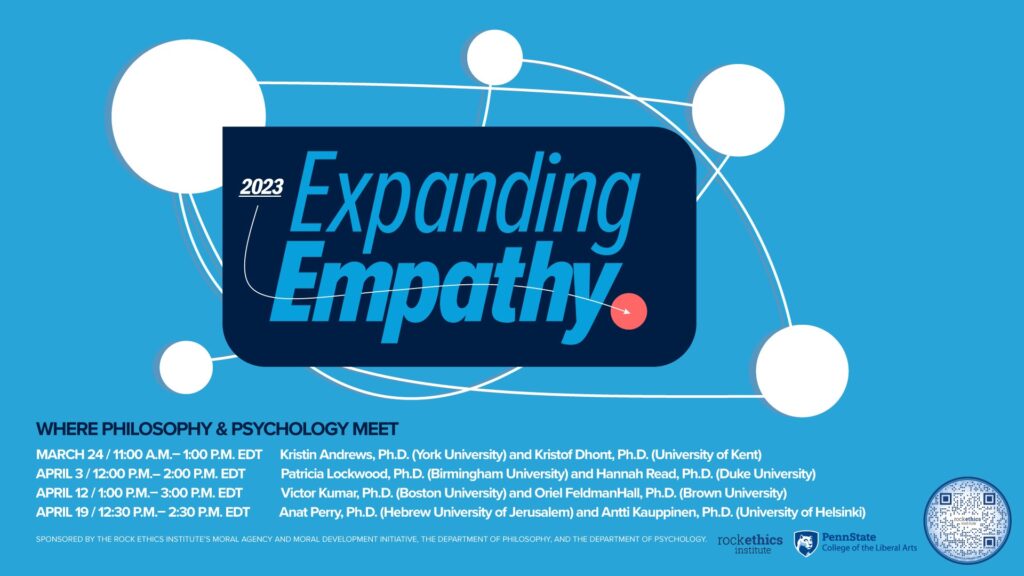Expanding Empathy Speaker Series: Ways to Channel Empathy

Anat Perry, Ph.D., is an associate professor at the psychology department at the Hebrew University of Jerusalem and the director of the Social Cognitive Neuroscience Lab. She studies social phenomena in terms of the interactions between their social (social cues, contexts, behaviors), cognitive (mental information processing mechanisms), and neural (neural representations and mechanisms) aspects. Her lab leverages a wide array of techniques, including behavioral testing, psychophysiology, EEG, Dual EEG and lesion studies, in healthy and clinical populations.
LECTURE TITLE: “The Contribution of Different Information Channels to Empathy and Social Communication”
ABSTRACT: Humans often depend on empathy, broadly defined as the ability to understand others’ thoughts and feelings. Empathy encompasses a cognitive dimension, understanding another person’s internal states, as well as an affective dimension, sharing the other person’s emotional states. For both processes, we may rely on auditory and visual cues to extract different kinds of information. In order to better differentiate the roles of the auditory and visual channels in social communication, we’ve created a modified version of the Empathic Accuracy Task, a naturalistic, ecological task and stimuli set that would enable examining different features of the empathic response.
Participants (“targets”) were videotaped describing affective autobiographical events, while we recorded their skin conductance and heart rate measures. Soon after being recorded, targets watched the videos of themselves and used a scale to continuously rate how positive or negative they had felt when telling the story. We now use these stimuli in a variety of paradigms, asking different participants to watch the same videos and, using an identical scale, continuously rate how they believe the targets felt at each moment. Time-series correlations between perceiver inferences and target ratings serve as a quantitative measure of interpersonal understanding (empathic accuracy, a more cognitive measure). Asking perceivers to rate their own affective response, as well as correlating the targets’ and perceivers’ physiological measures, indicate affective synchrony, or experience-sharing. I will present a set of behavioral, psychophysiological, EEG, and lesion data that give new insight on the role of the auditory and visual channels in empathy and social communication.

Antti Kauppinen, Ph.D., is professor of practical philosophy at the University of Helsinki. He has broad research interests in ethics, epistemology, moral psychology, and the history of moral philosophy. He has written extensively about the role of emotions in morality and about the nature and significance of various individual emotions, such as anger, pride, admiration, and suffering. He is currently the PI of the Academy of Finland research project “Responsible Beliefs: Why Ethics and Epistemology Need Each Other.”
LECTURE TITLE: “Empathy, Bias, and Manipulation”
ABSTRACT: Affective empathy, roughly speaking feeling emotion E for another as a result of attributing E or grounds for E to her, plays an important role in motivating altruistic behaviour, or acting for the sake of another. If I feel sad for your loss, I may be motivated to comfort or compensate you; if I feel angry for what someone did to you, I may be motivated to punish them. Often, this is a good thing, but as critics of empathy have rightly pointed out, acting for the sake of one person may be morally wrong, if it is at the expense of other people or of justice. This problem is particularly acute given that there are well-known biases built into affective empathy and its cognitive precursors. What is more, these biases can be exploited to manipulate people’s empathic responses, which may influence important political and personal choices.
Drawing on empirical literature, I sketch an overview of the known biases and methods of manipulation. Having argued in earlier work that to facilitate morally acceptable behaviour, empathic responses need to be regulated, I add some concrete suggestions for what this would require. For example, it may be best to refrain from more visceral visual and auditory representations of suffering, and instead rely on more detached written representations. This involves delicate balancing, since morally relevant information may be lost and detached representations may be deceptive. Development of moral virtue, I suggest, crucially involves learning to judge when and how to empathize with others.
